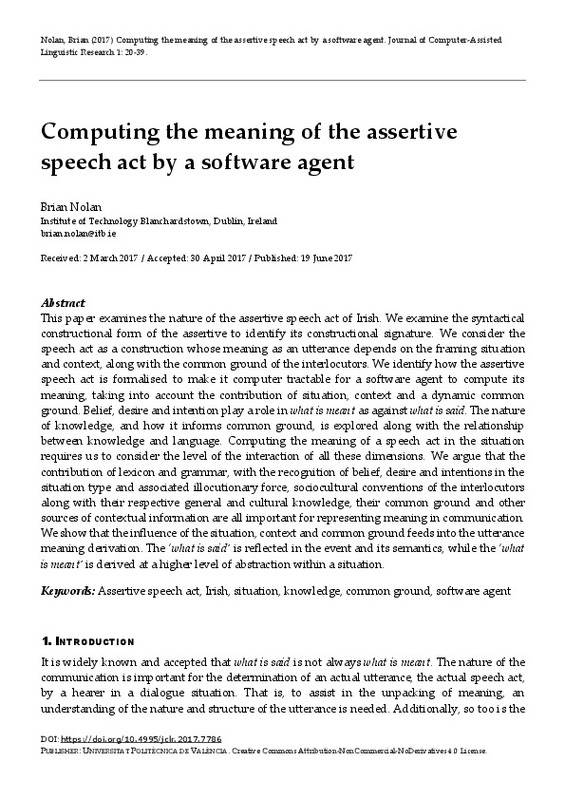JavaScript is disabled for your browser. Some features of this site may not work without it.
Buscar en RiuNet
Listar
Mi cuenta
Estadísticas
Ayuda RiuNet
Admin. UPV
Computing the meaning of the assertive speech act by a software agent
Mostrar el registro sencillo del ítem
Ficheros en el ítem
| dc.contributor.author | Nolan, Brian
|
es_ES |
| dc.date.accessioned | 2017-07-07T07:11:34Z | |
| dc.date.available | 2017-07-07T07:11:34Z | |
| dc.date.issued | 2017-06-26 | |
| dc.identifier.uri | http://hdl.handle.net/10251/84656 | |
| dc.description.abstract | [EN] This paper examines the nature of the assertive speech act of Irish. We examine the syntactical constructional form of the assertive to identify its constructional signature. We consider the speech act as a construction whose meaning as an utterance depends on the framing situation and context, along with the common ground of the interlocutors. We identify how the assertive speech act is formalised to make it computer tractable for a software agent to compute its meaning, taking into account the contribution of situation, context and a dynamic common ground. Belief, desire and intention play a role in what is meant as against what is said. The nature of knowledge, and how it informs common ground, is explored along with the relationship between knowledge and language. Computing the meaning of a speech act in the situation requires us to consider the level of the interaction of all these dimensions. We argue that the contribution of lexicon and grammar, with the recognition of belief, desire and intentions in the situation type and associated illocutionary force, sociocultural conventions of the interlocutors along with their respective general and cultural knowledge, their common ground and other sources of contextual information are all important for representing meaning in communication. We show that the influence of the situation, context and common ground feeds into the utterance meaning derivation. The ‘what is said’ is reflected in the event and its semantics, while the ‘what is meant’ is derived at a higher level of abstraction within a situation. | es_ES |
| dc.language | Inglés | es_ES |
| dc.publisher | Universitat Politècnica de València | |
| dc.relation.ispartof | Journal of Computer-Assisted Linguistic Research | |
| dc.rights | Reconocimiento - No comercial - Sin obra derivada (by-nc-nd) | es_ES |
| dc.subject | Assertive speech act | es_ES |
| dc.subject | Irish | es_ES |
| dc.subject | Situation | es_ES |
| dc.subject | Knowledge | es_ES |
| dc.subject | Common ground | es_ES |
| dc.subject | Software agent | es_ES |
| dc.title | Computing the meaning of the assertive speech act by a software agent | es_ES |
| dc.type | Artículo | es_ES |
| dc.date.updated | 2017-07-07T07:00:18Z | |
| dc.identifier.doi | 10.4995/jclr.2017.7786 | |
| dc.rights.accessRights | Abierto | es_ES |
| dc.description.bibliographicCitation | Nolan, B. (2017). Computing the meaning of the assertive speech act by a software agent. Journal of Computer-Assisted Linguistic Research. 1(1):20-39. https://doi.org/10.4995/jclr.2017.7786 | es_ES |
| dc.description.accrualMethod | SWORD | es_ES |
| dc.relation.publisherversion | https://doi.org/10.4995/jclr.2017.7786 | es_ES |
| dc.description.upvformatpinicio | 20 | es_ES |
| dc.description.upvformatpfin | 39 | es_ES |
| dc.type.version | info:eu-repo/semantics/publishedVersion | es_ES |
| dc.description.volume | 1 | |
| dc.description.issue | 1 | |
| dc.identifier.eissn | 2530-9455 |








